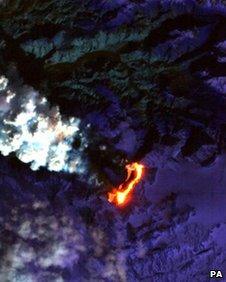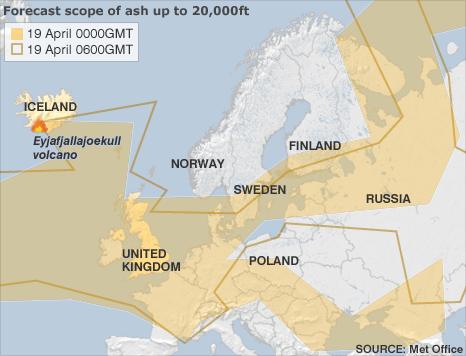Why volcanic ash from Iceland stops planes flying in UK
- Published

Restrictions were imposed on flights after a volcano erupted in Iceland
A cloud of volcanic ash from Iceland is continuing to cause cancellations at airports across the UK for a fifth day.
More than 6.8 million passengers have been affected so far, with airspace closed or partially closed in 20 European countries.
UK flights are suspended until 0100 BST on Tuesday at the earliest. It's still unclear exactly when things will start to get back to normal.
EU transport ministers are due to hold talks on Monday to discuss the crisis.
Check what's happening at your local airport at BBC Travel News
But why are flights in the UK and Europe being so badly affected by ash from a volcano in Iceland?
It's because the ash contains tiny particles of rock and even glass, which if they are sucked into a plane can wreck engines.
It's a bit like the way a flock of birds brought down the plane that crashed into New York's Hudson River.
Paul Haskins is from National Air Traffic Services (Nats): "Volcanic ash poses serious hazards to aircraft. Volcanic ash is quite a fine, abrasive powder and it can be quite damaging to modern jets' engineering and as such we have to restrict aircraft operation in those areas.
"The weather conditions are such that that volcanic ash is blowing southwards across Scotland and the North Sea and down into the Midlands area. Safety obviously is our number one priority.
"Volcanic ash poses a known and serious hazard to aircraft and as such we've had to restrict some aircraft operations in those areas."
Health
The ash isn't thought to pose a risk to people on the ground because it's so high up in the atmosphere - currently between 6,000m (20,000ft) and 11,000m (36,000ft). It's just a danger to planes.
In 1982, British Airways flight nine from London Heathrow to Auckland in New Zealand was forced to land in Indonesia after going through a cloud of ash.
All four engines on the plane failed after the explosion of Mount Galunggung in West Java and the jet glided without power for more than a quarter of an hour before the crew managed to restart three of the four engines.
A Singapore Airlines flight also lost three of its engines after flying through the same ash cloud a month later. Both planes also suffered serious external damage.
The ash cloud hadn't shown up on weather radars because it was still dry and the equipment used can only spot moisture in clouds.
The Geological Survey says volcanic ash is formed from explosive eruptions with particles as hard as a knife blade.
The ash can also melt in the heat of an aircraft engine then solidify again, disrupting the mechanics.
Volcanic ash
Russell Craig from Manchester airport says ash from volcanoes can't be spotted easily but will mean a spectacular red sunset.
He said: "You look out the window and everything looks perfectly normal, but rest assured it's not from an aircraft point of view.

Flights have been cancelled at airports across the UK including at Glasgow
"From a human point of view in the street it's perfectly safe but because of the way aircraft engines work - sucking in air, compressing it, forcing it out the other side to create thrust - if that's mixed with ash it can create a very dangerous situation."
Meanwhile in Iceland, hundreds of people have escaped after rivers rose by up to three meters (10ft).
Farmers have been advised to keep animals indoors to protect them from eating ash particles as sharp as glass.
The volcano under the Eyjafjallajokull glacier erupted on Wednesday for the second time in less than a month.

- Published15 April 2010
